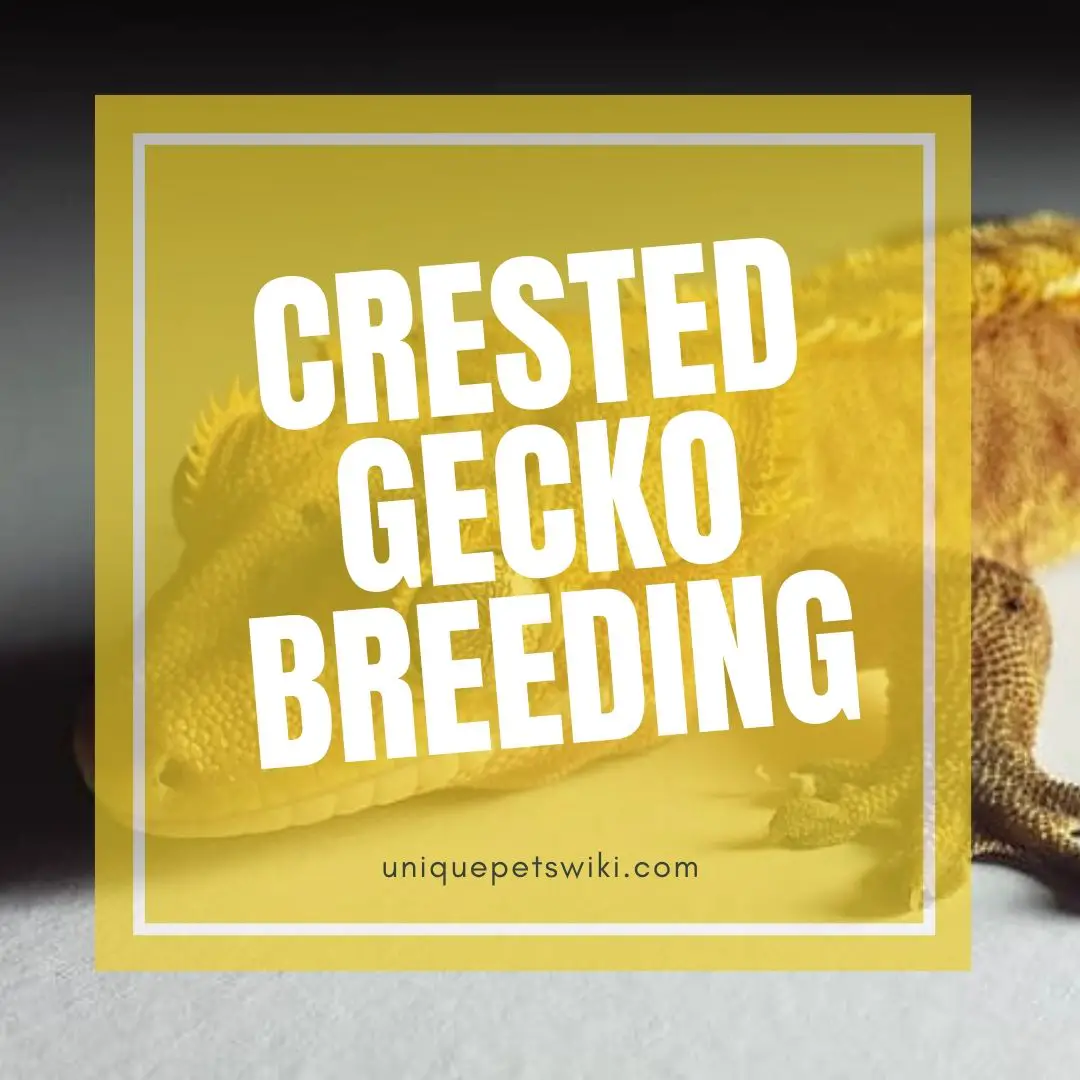Crested geckos are getting more and more popular among pet lovers, and you will find lots of breeders breeding crested geckos for several reasons. Breeding cresties is quite easy, and you do not have to worry too much if you want to breed them.
Crested geckos are prolific breeders in captivity if you can follow the numerous basic and essential steps. Everything that you need to know about crested gecko breeding is stated below.
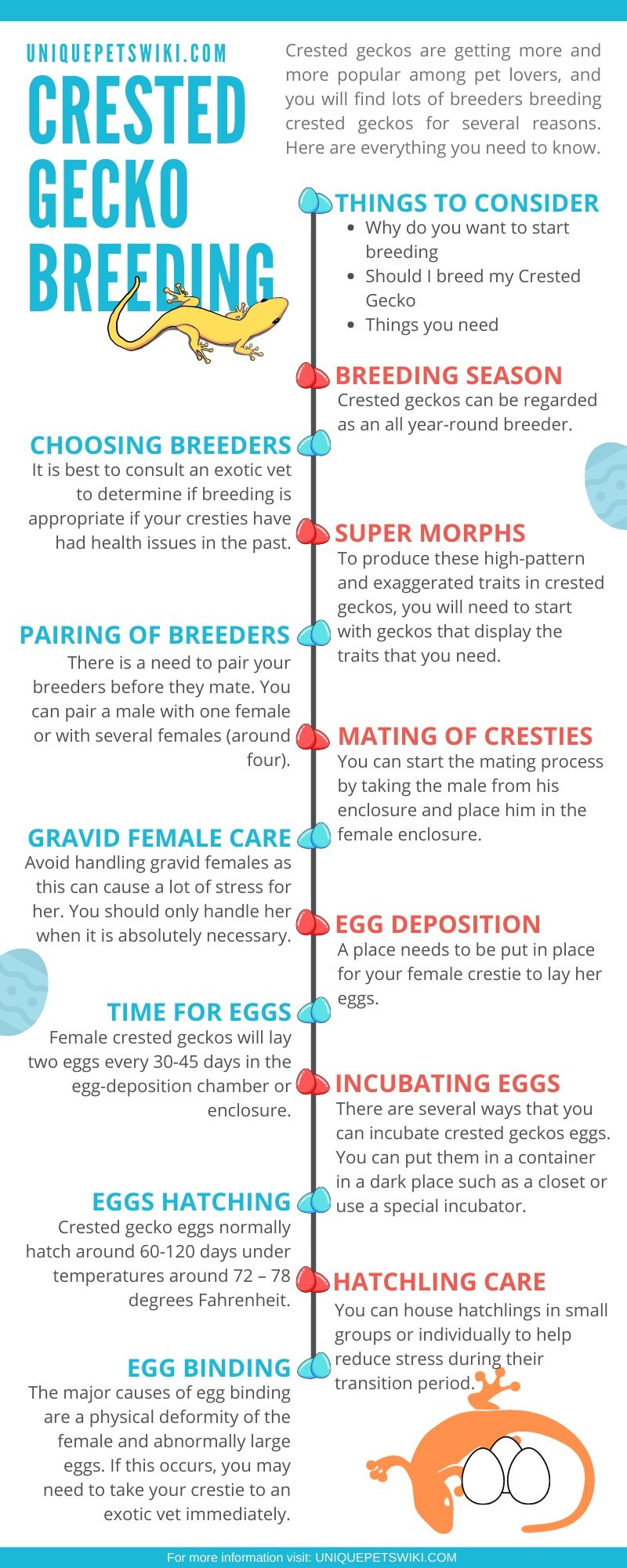
Contents
- Things to Consider Before Breeding Crested Geckos
- Is There a Crested Gecko Breeding Season?
- Choosing Breeders
- Pairing Of Breeders To Breed Your Crested Geckos
- The Mating of Crested Geckos
- The Gravid Female Care
- Crested Gecko Egg Deposition
- Time to Lay Some Eggs
- Incubating the Crested Gecko Eggs
- When Will the Crested Gecko Eggs Hatch?
- Why Did My Crested Gecko Eggs Not Hatch?
- Hatchling Care
- Egg Binding in Crested gecko
- Conclusion
Things to Consider Before Breeding Crested Geckos
Before you opt for breeding your crested geckos, you will need to consider some factors such as the list below:
Why Do You Want to Start Breeding Your Crested Geckos?
Before you start breeding geckos, you need to decide whether you want to breed for some money or just to expand your collection. You do not need to buy a lot of equipment if you’re going to keep the hatchlings for yourself.
However, if you want a profitable business out of crested geckos breeding, you will need to ensure you do not lose a lot of money. You will need to budget for a lot of food and care for the hatchlings for a while before selling.
Should I Breed My Crested Geckos?
Although technically correct, all you need to breed cresties successfully is a male and a female gecko. But you need to be an excellent crested gecko breeder and inspire others with your husbandry, productions, and breeding ethics.
For instance, most experienced breeders will not advise breeding the same morphs like two patternless geckos. This is not because the breeding will fail but because you want to produce reptiles that will add value to the market while finding homes for your hatchlings.
Unless you want to keep all the geckos, you produce, but you will not need 8-12 new geckos every season from the same parents.
It is best to produce crested geckos that crested geckos lovers want to buy and are genetically healthy. You should keep in mind that the crested geckos market is pretty flooded, and it will take an effort to sell them.
Be ready to post on social media groups, for-sale websites to sell your geckos. And if you do not have anything too special to sell, it will take time to sell it.
What Do You Need?
You do not need a lot of expensive equipment for breeding crested gecko. Some of the things that you will need are
- Weighing scale
- A pair of healthy crested geckos
- Incubation boxes and substrate
- Multiple terrariums for when you separate your breeder and hatchlings
- Egg-laying boxes and substrate
- Time for caring for the hatchlings
Most of the other items that you will use are those you are already using. Some of them are paper towels for lining the 6-quart bins, spray bottles, food and supplements, fake plants, disposable hides. For your hatchling enclosures, it is best to use disposable or bleachable items.
Ensure you clean their tubs and replace the paper towel and furnishings every week.Although most breeders sell their hatchlings when they are small (under 10g), you can have holdbacks.
Holdbacks are crested geckos that are hatched out, but you want to keep them until they are sub-adult before deciding to sell or keep them for future breeding.
You can either keep your holdbacks in 16-quart tubs that look like the disposable setup or use 10+ gallon terrarium with natural soil and plants.
Is There a Crested Gecko Breeding Season?
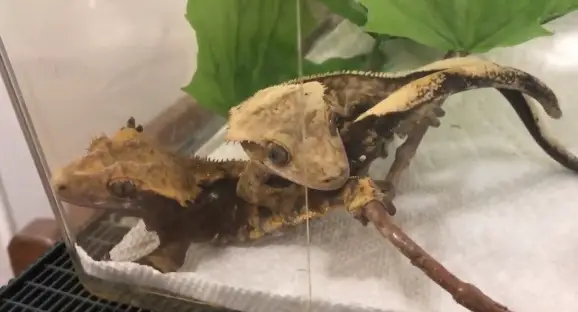
Crested geckos can be regarded as an all year-round breeder. However, they mate and lay eggs when they are the most active, usually during the warmer months, such as spring, fall, and summer. The breeding season for crested geckos starts in February or March and will end in October.
This gives them around 3-4 months of resting period. However, you can breed them all year round in an artificially controlled heating and lighting enclosure. Whether you decide to breed your crested geckos during the offseason or not is up to you.
But you should keep in mind that it is quite tricky to fool their natural clocks. It is best to give your female cresties a break for a few months between seasons to regain their fat and calcium reserves.
Although the females will stop laying on their own, you can remove the males or cohabitating females. This is to ensure that they get enough rest and food to recover completely.
After several seasons of routine egg-laying, you may need to give your female a year off to recover. Crested geckos can breed through their lifetime, and you do not have to make them breed every year.
New to crested gecko? Check out the crested gecko care sheet now! We had listed out all the things you need to know about crested gecko as pets. Check it now!
Choosing Breeders
A good breeder will depend mostly on the traits that you are searching for. Whether you are breeding for pattern, structure, or color, ensure that your breeders are healthy with no signs of calcium deficiencies or other health problems.
It is best to consult an exotic vet to determine if breeding is appropriate if your cresties have had health issues in the past. Although it is the female crested geckos can use lots of their internal resources to produce eggs. You will need to make sure the males are from good genetic stock and are free from defects.
Many breeders choose less intensely colored or patterned cresties to maintain the wild look to crested geckos while many breeds for exaggerated crested geckos traits.
How Do I produce super morphs?
The super morphs are considered the extreme versions of existing morphs. The morphs that are regarded as the super are for traits like the pinstripe or dalmatian spots. Some other super morphs are super tiger, extreme harlequin, or super brindle morphs.
To produce these high-pattern and exaggerated traits in crested geckos, you will need to start with geckos that display the traits that you need. You should only breed the ones displaying the trait while you avoid inbreeding.
It is best to use cresties with the visual presence of the trait that lineage trait. This is because you cannot know if the crested geckos inherit the genes you want to produce.
It is preferable to use a male who displays the best traits you need to breed him with multiple lower-quality females. However, you may have a female with the best trait, and you need to find the best mate for her. Another thing is that great males are easier and cheaper to come by.
However, avoid inbreeding of commonly present traits like a super dalmatian, extreme harlequin, and full pinstripe. You can only try inbreeding when you want to bring a brand new trait or establish the genetic inheritance probabilities.
Pairing Of Breeders To Breed Your Crested Geckos
There is a need to pair your breeders before they mate. You can pair a male with one female or with several females (around four).
When Can My Cresties Pair?
The natural breeding cycle for crested geckos is 8-9 months, usually from March to September. Ensure that both the male and female are sexually mature before starting the mating process. The female cresties need to be 18 months old and weigh a minimum of 35-40g. It is important that the female has sufficient calcium stores before breeding them.
During the breeding process, you should also give her dusted insects and calcium lick.
The Mating of Crested Geckos
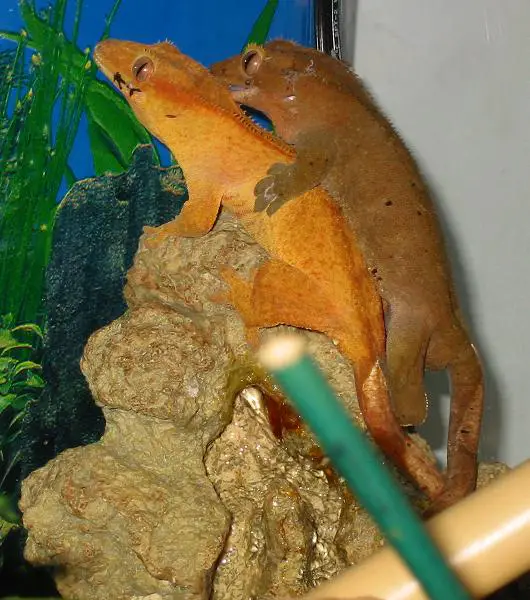
You can start the mating process by taking the male from his enclosure and place him in the female enclosure. When introducing the male, always be extra careful. This is because male crested geckos can be quite aggressive and hurt the female.
Male crested geckos will chase the female around the enclosure and will mount her from behind. The male will also bite the head of the female multiple times during the mating process. When mating, you may hear some weird sounds like squawks and squeaks, which is pretty normal.
If you notice an open wound from when the male crestie bites in the skin of the female. You will need to remove the female immediately. There is a need to clean the wound with water and treat with antibiotics until it heals. After the female recovers, you can then introduce the male again.
How Long Does the Mating Take?
Mating of crested geckos may start within the few hours that you introduce the male to the female. Crested geckos may mate only once but can also mate multiple times. As a breeder, it is best to leave the pair together for around a week to ensure they mate multiple times.
Do I Leave the Pair Together After Mating?
Usually, there is no rule whether you should leave the pair together after mating. Some breeders leave the pair to stay together in the same tank, while others will separate them. This means you will need to decide whether to leave them or not.
Leaving them will be based on the behavior of both cresties towards each other. If they are not aggressive towards each other, you do not need to separate them. If otherwise, you will want to keep them separate from each other.
Tips and Tricks During Mating
Some of the tips and tricks that can help the first-time breeder make your gecko comfortable and stay healthy are stated below.
Create an Optimal Rate of Male to Female
Male cresties are usually aggressive towards each other when they are sexually mature. It is best to keep adult crested geckos away from each other. During crested gecko breeding, it usually involves a pair of geckos or one male gecko with several females (around four)
Creating a Resting Period
The male will not stop mating with the female if you keep the male and female cresties in the same tank the entire year. Mating all year can be stressful for female cresties and can cause health issues. There is a need to introduce a resting period of 3-4 months. This helps your female cresties to rest and regain their strength.
You can create a resting period by mimicking their natural habitat. During this period, you can cool down the temperature in the tank to around 60-65 degrees Fahrenheit.
Ensure You Treat Severe Bite Marks and Wounds
Most bite wounds will go away after a female sheds her skin. However, there are times when the male bites too hard that will cause an open wound. If this happens, you will need to remove the female immediately from the male.
You can treat the wound with antibiotics until it has healed before reintroducing the female and male.
The Gravid Female Care
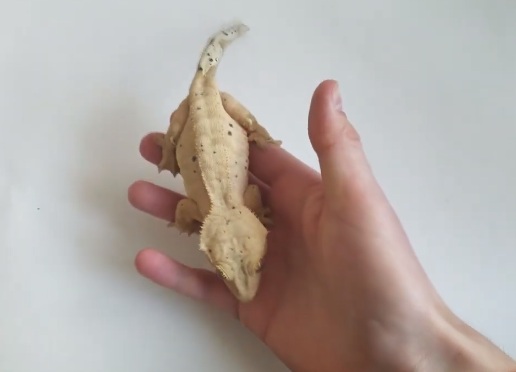
(Source: Sostic YouTube)
A pregnant crested gecko is usually called a gravid female. After a very short period of crested gecko breeding, the female crestie will become pregnant. If you are a first-time breeder, you may not notice that your crested gecko is already gravid.
Tips to determine if a female is gravid
- The female becomes reclusive and will stay in her hiding places
- The female starts to stay in the warmer areas of the terrarium
- Increased appetite until it is time to lay eggs.
Note: avoid handling gravid females as this can cause a lot of stress for her. You should only handle her when it is absolutely necessary.
Crested Gecko Egg Deposition
A place needs to be put in place for your female crestie to lay her eggs. Most breeders usually create a separate egg-deposition chamber for the female to lay her eggs. And so they can easily locate them. However, they are some breeders that will let the females lay the eggs in the enclosure.
Preparing an Egg-Deposition Chamber
There is no need to spend a lot of money to make an egg-deposition chamber. You can use a plastic container that measures 8x5x5 inches. You will then fill half of the container with slightly damp moss. You can use other types of loose substrates, such as a mixture of peat moss and vermiculite.
Seal the chamber with a lid and cut a hole of 2 inches wide in the lid. The hole is for easy entry and exit of the female into the chamber.
Egg-Deposition in an Enclosure
If you opt not to use a separate egg-deposition chamber for your gravid cresties. You will need to provide them with a moist area in the substrate of the tank. The moist area will be the special place where the female can bury the eggs.
Gravid female crested geckos will lay her eggs at night. She will dig a hole in the substrate to lay her eggs and cover them up with the substrate. However, it can be a little difficult to locate the eggs if you do not use an egg-deposition chamber.
Time to Lay Some Eggs
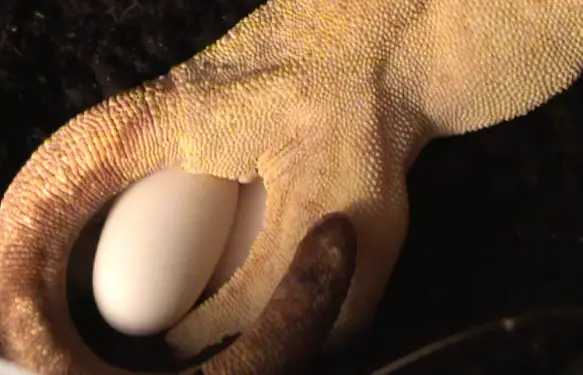
(Source: JB’s Cresties YouTube)
Female crested geckos will lay two eggs every 30-45 days in the egg-deposition chamber or enclosure. During the breeding season that will last around eight months, it will lay an average of 6-10 clutches.
After laying the eggs, you will need to remove them from the chamber or enclosure within 24 hours. If you do not remove them within the period, the eggs may dehydrate and not hatch when incubated. Always be very careful when handling the eggs.
Remove the eggs individually and put them in the incubation box. When transferring the eggs, ensure you do not rotate them as it may detach the embryo from the shell.
New to crested gecko? Check out the crested gecko care sheet now! We had listed out all the things you need to know about crested gecko as pets. Check it now!
What should crested geckos eggs look like?
- It is small and flexible
- It should be pearly white with a light pink spot
- Yellow eggs that have thin and soft shells are not usually viable.
How Often Do Crested Geckos Lay Infertile Eggs?
Female cresties will naturally start laying eggs once they are a year old and about 25-35g. They will lay a clutch of infertile eggs if you do not expose them to a male. It is best to introduce a male to your female once they reach this stage.
You should keep in mind that big or fat female cresties are not healthy and productive breeders. This is why you should avoid fattening up a female for breeding with baby food. During the breeding process, the nutrition you give your gecko is more crucial than a gecko size.
Incubating the Crested Gecko Eggs
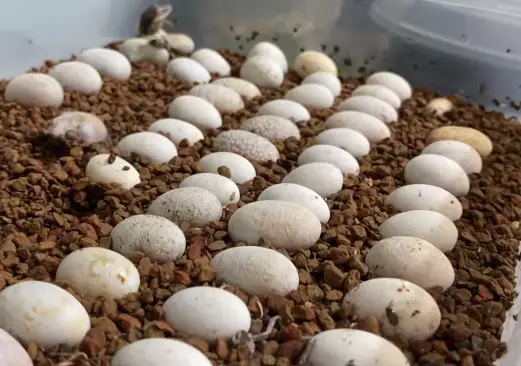
(Source: TikisGeckos YouTube)
There are several ways that you can incubate crested geckos eggs. You can put them in a container in a dark place such as a closet or use a special incubator. Both methods are good, and you do not need to invest in an incubator if you have a low budget.
Using an Incubator
The major benefit of keeping eggs in incubators is that they will be at a certain temperature without any fluctuations. You will find several incubators that you can use for incubating reptile eggs. Ensure that you go for an incubator that can hold a consistent temperature.
However, you can also create your incubator if you are quite handy. What you will need to make one is a 10-gallon aquarium with a few inches of water. You can then use an aquarium heater to heat the aquarium to the specified temperature.
Place a brick in the water and then place a container with the eggs on the brick. You will then use a top to keep the heat and moisture in the tank.
Using an Incubation Box
You will need to make your incubation box if you opt not to use an incubator. A plastic container or a shoebox filled with a 2/3 substrate will be needed for this process. Some of the substrates that you can use are perlite, superhatch, vermiculite, or hatchrite.
Ensure that the substrate is moist, but it is not dripping wet. You will also create 5-8 1/8 inch holes in the lid for ventilation. Place the eggs in substrates and put a lid on before placing the box in cool and dark spots like a cupboard or closet.
When Will the Crested Gecko Eggs Hatch?
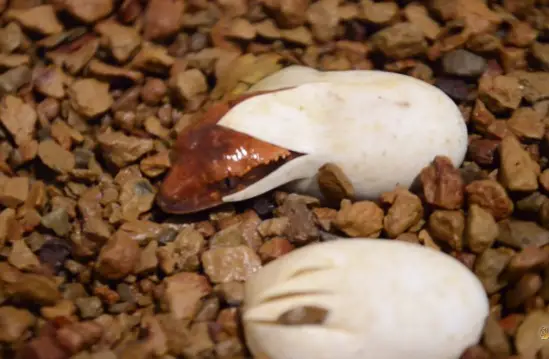
(Source: TikisGeckos YouTube)
Crested gecko eggs normally hatch around 60-120 days under temperatures around 72 – 78 degrees Fahrenheit. Hatching may last longer if the environment but will not if the environment is hotter. However, you will need to check the eggs every day after 24 days.
Why Did My Crested Gecko Eggs Not Hatch?
There are times when the eggs will be nonviable. There are several factors that can make an egg not to hatch; some of them are stated below.
- Poor health of the female
- The male did not fertilize the egg
- There was not enough calcium.
Hatchling Care
After the hatchlings are fully developed, they will poke a hole in the eggshell and will come out. This process is known as piping.
The hatchlings may not come out fully as some will stay in the shell to absorb the nutritious yolk. You should avoid removing them from the eggs but wait until they absorb the yolk.
You may remove the babies immediately to a hatchling enclosure or wait until after their first shed, and they will experience their first shed within 12 – 24 hours after hatching. The hatchling enclosure is usually the smaller version of the adult’s tank.
It is best to use a paper towel to line the enclosure and ensure the décor is very simple. You do not need to add more than a small plant and twisted vine in the tank. Provide them with food and water dishes that are shallow for them to eat and drink from easily.
You can house hatchlings in small groups or individually to help reduce stress during their transition period. There is a need to mist their tank twice daily and provide a moist hide to help prevent shedding problems.
You can offer your baby geckos with food immediately after their first shed is complete.
Egg Binding in Crested gecko
This is a serious situation that occurs when a gravid female cannot lay mature eggs formed in her reproductive system. If this occurs, you may need to take your crestie to an exotic vet immediately.
Symptoms of egg binding in cresties can be hard to tell for an inexperienced breeder. However, some of the symptoms to be on the lookout for are loss of appetite, lethargy, and bloated stomach.
Causes of Egg Binding
The major causes of egg binding are a physical deformity of the female and abnormally large eggs. Another common cause of egg binding is the gecko’s poor health, and a common cause is calcium deficiency. Egg binding can occur in first time breeding females or even unbred females.
Solution
- Give your female cresties a lukewarm baths
- Gently massage the egg area
Note: These two methods can be very risky, and the best option is to consult a vet that specializes in reptile care. This is because egg binding can be dangerous to the animal’s health and can cause death.
Conclusion
Breeding crested geckos are usually fun and exciting. You will find out that it is pretty straightforward. However, egg-laying can take its toll on a female, and it is best to give her a resting time.
